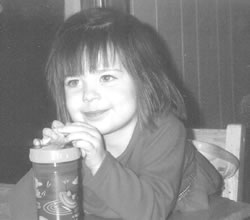Alyssa's ray of hope
A young child’s fight against autism
- November 1, 2002
- |
- Grace Moss, Staff Writer
- Section: News
Each year the Leaders in Residence class on campus gets involved with service projects around the community. One of the projects this year involves a UTM graduate from 1985, Penny Ray, and her 3 year old daughter, Alyssa. Alyssa is fighting against autism, which is a neurological disorder that affects a person’s social and mental development. Autistic individuals avoid eye contact and often engage in repetitive behavior.
While Alyssa sat silently, stroking a single strand of hair over and over and over, her twin brother, Alex, would spend his time playing with toys and being a mischievous toddler. Alyssa would often repeat one phrase, such as "okey-dokey", for an hour at a time. Penny did not want to accept that it might be autism, because she did not want her daughter to be compared to Rain Man, referring to a 1988 film about an autistic man starring Dustin Hoffman.
The Rays finally accepted the fact that their daughter was autistic and began to research on ways to help her. Penny found out about a therapy called Applied Behavior Analysis (ABA). To be effective the therapy has to be done before the age of 6 while the brain is still developing. Therapists work one-on-one with Alyssa eight hours a day in her home, charting and graphing her progress. But such a home program can cost families $25,000-$35,000 a year.
Through this therapy over the last year and a half, Alyssa has gone from being able to follow simple movements to being able to follow movements with five or six steps. She has gone from a vocabulary of three words to more than three hundred. Four to five word sentences are being put together and making sense to Alyssa now. She makes eye contact and can be pulled out of her own world. How far will Alyssa go? Nobody really knows, but her family and friends are hopeful.
“One of the most joyful sights I’ve ever had is when her hair flipped around when she turned and looked at me in response,” Penny says, tears filling her eyes. Progress is measured with small steps: identifying colors, making eye contact, when she responds to her name.
The days are long and hard for the family. Penny finds herself exhausted at the end of most days; but if she gets angry, it is at scrambling to find the money to do what needs to be done.
“That’s when I find the 'it's not fair' feeling welling up inside.
People all around us are throwing money away. We’re investing in a child, which is a much smarter investment than any stock or mutual fund…automobile or stylish clothing.”
For now, Penny and Dale Ray say their goal will be to have their youngest daughter “recovered”, which they define as making sure Alyssa is “indistinguishable from her peers.”
How can you help? Members of the Leaders In Residence class will be set up outside the cafeteria Tuesday, Wednesday and Thursday (November 5, 6 & 7) with empty jars. The class is asking you to “Empty Your Pockets” of any loose change or any other donation into these jars; so that when we are done, the jars are no longer empty but filled with a hopeful future for Alyssa and her therapy.

Alyssa sits innocently not aware of the struggle that she is fighting on a daily basis with autism. For a person that has autism, home treatment and observance can cost families $25,000- 35,000 a year.